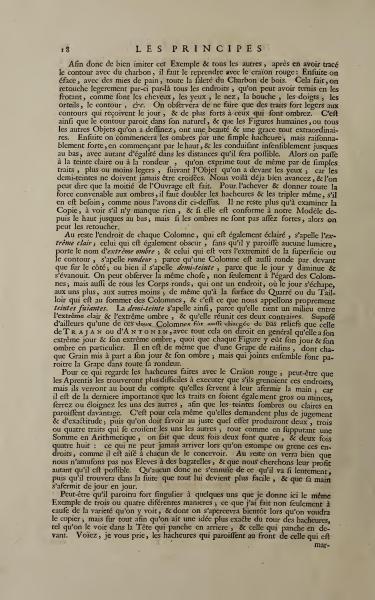The Principles
To effectively mimic this example and all others, after sketching the outline with charcoal, it should be refined with the red pencil. Then erase all the smudges of the charcoal using breadcrumbs. Once done, lightly revisit certain spots, which might have been blurred by rubbing, like hair, eyes, nose, mouth, fingers, toes, and outline, etc. It is important not to make strong lines on contours exposed to light, while stronger ones should define the shaded areas. This way, the outline appears natural, and the human figures or any other delineated objects possess extraordinary beauty and grace. Next, begin shading with a simple hatching method; moderately strong at first, starting from the top and gradually narrowing to the bottom with consistent spacing. Then, progress to the light tone or roundness, expressed similarly with simple strokes, lighter or stronger, depending on the object in view; half-tones should never cross. At this stage, half the work is complete. To finalize and give suitable depth to shadows, double or triple the hatchings as necessary, as previously mentioned. Finally, check the copy to ensure nothing is missing and that it aligns with our model from top to bottom; if shadows seem weak, retouch them.
Additionally, the illuminated part of each column, known as the extreme light, and the fully shaded part named the extreme shadow, near the surface or contour, called roundness, reflect light in decreasing intensity. This concept also applies to all round bodies, where light escapes from some areas more than others, akin to the square surface or chisel end which sits atop columns, commonly referred to as fading tones. The half-tone is thus termed because it sits between extreme light and shadow, harmonizing these opposites. Hence, any of these columns, laden with bas-reliefs resembling those of Trajan or Antoninus, will generally show both extreme light and shadow, even though each figure has its shadow and light. Just like clusters of grapes, each grape has part of the light and shadow, but when combined, reveals the whole cluster in full roundness.
In terms of marks made using the red pencil, apprentices might find them more challenging to execute compared to shading those areas; however, they will come to realize that these methods strengthen their hand. It is crucial for strokes to be at even thickness whether extended or shortened, as this enhances how light or dark patches are perceived. This same reason demands more judgment and accuracy, for one must know precisely the effects produced when two, three, or four strokes intersect, much like calculating sums in arithmetic: twice two makes four, twice four is eight, which can never occur when smudging or shading these areas, as anyone can comprehend. We ensure our students are not distracted by trifles, aiming for practical benefit as much as possible. No one should be disheartened by gradual progress, as eventually, everything becomes easier and their hand steadier day by day.
Some might find it peculiar that I present the same example in three or four different styles, which I do not only to highlight the variety visible therein, but particularly to give a more accurate understanding of the direction of the hatchings, as observed in the head tilted backward, and forward. Here, please observe, the hatchings at the forefront of the one seemingly appearing more distinctly.
Translation Notes
Hatching: A shading technique using parallel or intersecting lines. Breadcrumbs: In historical context, used to clean smudged charcoal from paper. Fading tones: Transitional shading from dark to light.
The document provides instructions on how to refine charcoal drawings using red pencil and erasing techniques to achieve natural shading and outlines. It discusses the use of hatching to create light and shadow variations, ensuring neither overpowers the sketch. The text emphasizes accurate, consistent strokes and understanding the interplay of light, shadow, and the form for effective drawing.
